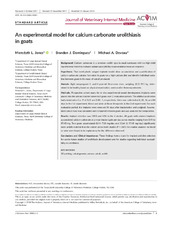| dc.creator | Jones, Meredyth L | |
| dc.creator | Dominguez, Brandon J | |
| dc.creator | Deveau, Michael A | |
| dc.date.accessioned | 2020-09-06T19:19:17Z | |
| dc.date.available | 2020-09-06T19:19:17Z | |
| dc.date.issued | 2018-03-10 | |
| dc.identifier.citation | Jones, ML, Dominguez, BJ, Deveau, MA. An experimental model for calcium carbonate urolithiasis in goats. J Vet Intern Med. 2018; 32: 1268– 1273. https://doi.org/10.1111/jvim.15061 | en |
| dc.identifier.uri | https://hdl.handle.net/1969.1/188919 | |
| dc.description | This article is also available at the journal website: https://onlinelibrary.wiley.com/doi/full/10.1111/jvim.15061 | en |
| dc.description.abstract | Background: Calcium carbonate is a common urolith type in small ruminants with no high-yield experimental model to evaluate animal susceptibility or preventative measure response.
Hypothesis: That novel plastic winged implants would allow accumulation and quantification of calcium carbonate calculus formation in goats on a high-calcium diet and identify individual variation between goats in the mass of calculi produced.
Animals: Eight nonpregnant 3- and 4-year-old Boer-cross does, weighing 22.3–39.5 kg, determined to be healthy based on physical examination, were used in these experiments.
Methods: Prospective cohort study for in vivo experimental model development. Implants were placed into the urinary bladder lumen in 8 goats over 2 evaluation periods. The alfalfa-based ration had a total ration Ca : P of 3.29 and 3.84 : 1, respectively. Urine was collected at 0, 28, 56, and 84 days in the 1st experiment; blood and urine at those timepoints in the 2nd experiment. For each evaluation period, the implants were removed 84 days after implantation and weighed. Accumulated calculi mass was calculated and compared between goats and was analyzed for composition.
Results: Implant retention was 100% and 86% in the 2 studies. All goats with retained implants accumulated calcium carbonate at a mean implant gain per day across studies ranging from 0.44 to 57.45 mg. Two goats accumulated (0.44–7.65 mg/day and 33.64 & 57.45 mg/day) significantly more urolith material than the cohort across both studies (P5.047). No routine analytes on blood or urine were found to be explanatory for the difference observed.
Conclusions and Clinical Importance: These findings form a basis for implant and diet selection for use in future studies of urolithiasis development and for studies regarding individual susceptibility to urolithiasis.
KEYWORDS
3D printing, calculogenesis, urinary calculi, urolith | en |
| dc.description.sponsorship | Funding information: Department of Large Animal Clinical Sciences, Texas A&M University College of Veterinary Medicine | en |
| dc.language.iso | en_US | |
| dc.publisher | American College of Veterinary Internal Medicine | |
| dc.rights | Attribution-NonCommercial-NoDerivatives 4.0 International | en |
| dc.rights.uri | http://creativecommons.org/licenses/by-nc-nd/4.0/ | |
| dc.subject | Veterinary Medicine | en |
| dc.subject | 3D printing | en |
| dc.subject | Calculogenesis | en |
| dc.subject | Urinary Calculi | en |
| dc.subject | Urolith | en |
| dc.subject | Goats | en |
| dc.title | An experimental model for calcium carbonate urolithiasis in goats | en |
| dc.type | Article | en |
| local.department | Large Animal Clinical Sciences | en |
| local.department | Small Animal Clinical Sciences | en |
| dc.identifier.doi | 10.1111/jvim.15061 | |



